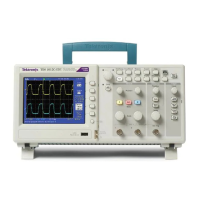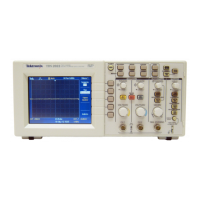Reference
scale setting.
You can use this mode in many situations, such as to monitor the
level of a power supply output.
Use the Auto mode to let the acquisition free-run in the absence of a valid trigger.
This mode allows an untriggered, scanning waveform at 100 ms/div or slower
time base settings.
The Normal mode updates displayed waveforms only when the oscilloscope
detects a valid trigger condition. The oscilloscope displays older waveforms until
the oscilloscope replaces them with new ones.
Use the Normal mode when you want to see only valid triggered waveforms.
When you use this mode, the oscilloscope does not display a waveform until
after the first trigger.
To perform a Single Sequence acquisition, push the Single button.
Source Options.
Source option Details
CH1, CH2, CH3
1
,CH4
1
Triggers on a channel whether or not the w aveform is
displayed
Ext Does not display the trigger signal; the Ext option uses the
signal connected to the Ext Trig front-panel BNC and allows
a trigger level range of +1.6 V to -1.6 V
Ext/5 Same as E xt option, but attenuates the signal by a factor of
five, and allows a trigger level range of +8 V to -8 V; this
extends the trigger level range
AC Line
2
Uses a signal derived from the power line as the trigger source;
trigger coupling is set to DC and the trigger level to 0 volts.
You can use the AC Line when you need to analyze signals
related to the frequency of the power line, such as lighting
equipment and power supply devices; the oscilloscope
automatically generates the trigger, sets the Trigger Coupling
to DC, and sets the Trigger Level to zero volts.
1
Available only o n a 4-channel oscilloscope.
2
Available only when you select the Edge trigger type.
NOTE. To view an Ext, Ext/5, or AC Line trigger signal, push and hold down
the Trig View button.
Coupling. Coupling allows you to filter the trigger signal used to trigger an
acquisition.
Option Details
DC Passes all components of the signal
Noise Reject Adds hysteresis to the trigger circuitry; this reduces sensitivit
y
which reduces the chance of falsely triggering on noise
TDS2000C and TDS1000C-EDU Series Oscilloscope User Manual 97

